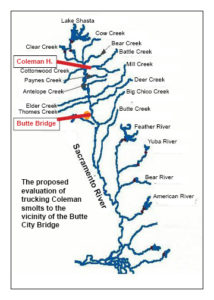
Currently, the coded wire tag data shows that when juvenile salmon called smolts are released at the Coleman hatchery, often very poor returns result due to predation. The exception is after high water years when heavy runoff increases juvenile salmon survival. Past trucking of Coleman Hatchery fish, born and reared in Battle Creek water, has resulted in high stray rates, presumably because they never get a chance to imprint on Sacramento River water. But trucking these fish at least part way downstream is being tried to offset the upper river becoming a more hostile migratory corridor, presumably due to increased water diversions. Losses in the upper river of Coleman fish have been well documented.
This proposal calls for an experiment with the trucking and net pen acclimating of some Coleman hatchery fall-run smolts part way down the Sacramento River to see if low survival and low straying can be achieved.
This project includes trucking to a net pen location 60 or 70 miles down the river to test if some of the worst predation in the upper river can be avoided. Below Hamilton City, there are still over 30 miles of natal Sacramento water where imprinting can take place before reaching Butte Creek, the next major tributary.
